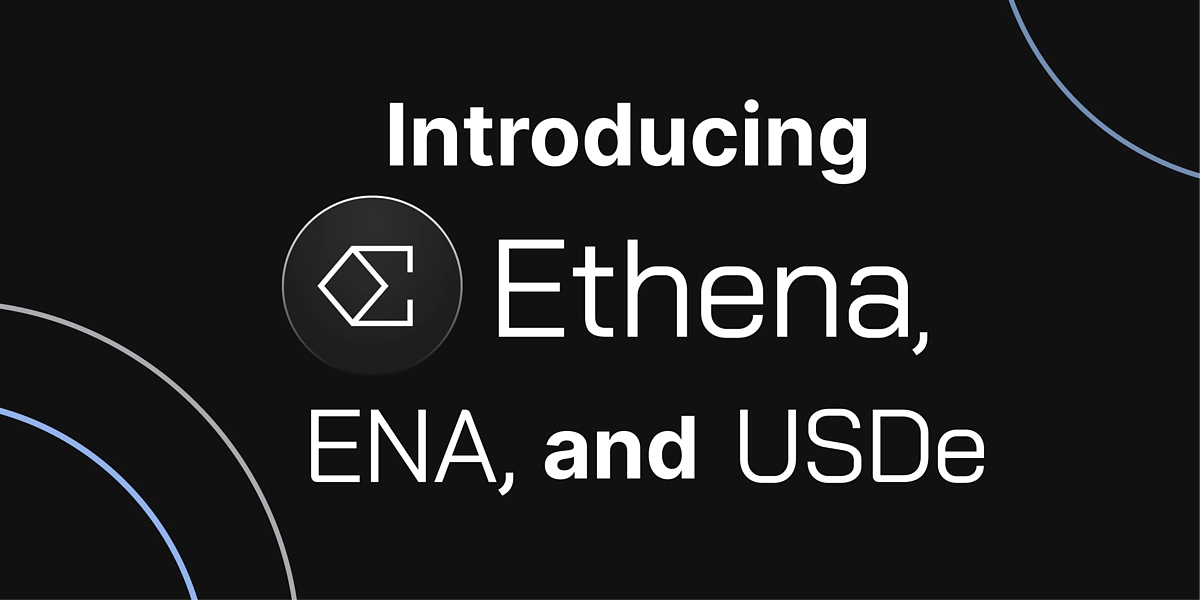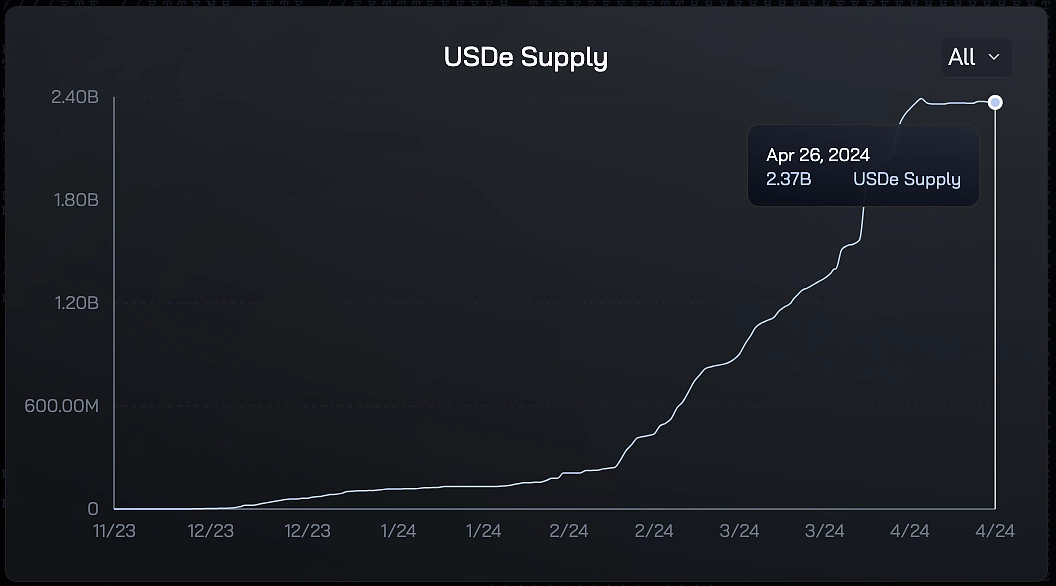What Is Ethena?
Ethena is the project behind USDe, a synthetic dollar backed by assets including ETH, stETH, BTC, and USDT. USDe does not rely on traditional financial infrastructure, nor does it require overcollateralization.
Key Takeaways
-
The supply of USDe has grown past $2.3 billion at the time of writing.
-
Ethena uses a delta-hedging mechanism to manage the risk associated with the fluctuation in the value of the backing assets. This is done via a relative short position created against the backing assets in a derivatives exchange.
-
USDe can be spent like any other digital asset and users accrues value through protocol yield by staking idle USDe with Ethena.
-
ENA, the native token of Ethena, is used for governance and can also be locked for rewards on selected platforms.
-
This article explains how USDe and Ethena protocol works to create a form of money bonded to the internet.

This article is brought to you by Ethena.
One of the biggest challenges facing the crypto space is the lack of a crypto-native solution for a globally accessible dollar denominated financial instrument that doesn’t rely on traditional banking infrastructure. Currently, crypto assets referencing the US dollar play a vital role in the operation of the crypto space, as they offer users a way to preserve their capital, removed from the volatility of cryptocurrencies.
Centralized stablecoins like USDC and USDT are stable and scalable, but they have a heavy reliance on traditional financial infrastructure and custodial risk. Likewise, decentralized stablecoins that don’t rely on traditional financial infrastructure face issues like scalability and instability around mechanism design.
Ethena believes that the crypto space could benefit greatly from a form of money bonded to the sector, developed with practices that correspond to its principles. Toward this goal, it is building strategies and technologies to bolster USDe, a synthetic dollar built around crypto.
Over $400 million worth of USDe was minted within the first week of public launch and this has grown by over $1.8 billion just about 8 weeks later. At the time of writing, the supply of USDe sits at $2.37 billion as the industry’s’ interest in the project grows.
Introducing Ethena
Ethena is a protocol built for the minting, redemption, and staking of USDe. It is designed to oversee key operations like minting, redeeming, collateral and risk management, staking, and other aspects of USDe. Ethena consists of smart contracts, position management algorithms, and off-protocol operations that work in synergy to ensure that the USDe functions as expected. Ethena enables the minting and redemption of USDe through a smart contract-controlled processes.
According to the project, Ethena aims to develop a crypto-native financial solution by creating a synthetic asset that intends to closely mirror the value of the US dollar. While USDe is not a stablecoin like USDT or DAI, it’s intended that the price of USDe remains around one US dollar.
Ethena does this by constructing a position that has the aggregate value of a dollar on a relatively consistent and mostly predictable basis. To protect USDe from risks associated in the value of underlying assets, Ethena opens a short position on the collateral asset on derivatives exchanges (in the same notional amount of spot backing held). This is expected to keep USDe relatively stable, even in extreme market conditions.
What Is USDe?
USDe has seen impressive growth since its public launch, reaching a supply of $400 million within the first week and climbing to over $2 billion barely two months later.

USDe can be minted by whitelisted participants using any of the supported collateral assets, which as of this writing includes USDT, ETH, and liquid staked Ether (stETH), as well as the recent addition of BTC. Since integration, BTC has become a significant component of USDe’s backing, accounting for about 35% of the pool’s value at the time of writing:

USDe can be traded against other crypto assets on supported centralized and decentralized exchanges, used to obtain loans on lending protocols that have integrated it, or any other purposes via integrations by supporting protocols and platforms. By way of example, MakerDAO announced the integration of USDe into the Spark platform, whereby users can deposit USDe to borrow DAI through Spark based on the breakdown here.
How USDe Maintains Its Value
USDe is not overcollateralized by minter assets, and whitelisted users can mint an amount of USDe equal to the value of the backing provided minus operational costs.
As a synthetic dollar backed by assets whose value fluctuates, Ethena Protocol protects the backing of USDe from market price fluctuation via delta-hedging. This strategy involves taking offsetting positions in derivatives markets to neutralize the price movements of the USDe’s backing assets. When USDe is minted, an equivalent short position is opened on a derivatives exchange such that any loss in the value of the backing asset is generally balanced by gains from the short position, and vice versa.
The protocol incorporates ‘Off-Exchange Settlement’ providers to handle the asset availability for the minting, redemption, and hedging process. When USDe is minted, the protocol transfers the provided backing assets to the Off-Exchange Settlement solution wallet and instructs the Off-Exchange Settlement provider to delegate funds to a derivatives exchange. The solution is used to open an offsetting short position and to ensure no backing asset is ever exposed to centralized exchange counterparty risks.
A reverse procedure is followed when USDe is redeemed. A corresponding short position is closed as the protocol sends the backing asset to the redeeming wallet, and USDe holders will burn USDe in exchange for backing assets of equal value.
According to Ethena, using an off-exchange settlement provider protects the system from risks associated with centralized exchanges and allows easy auditing of the asset managed by the protocol.
Ethena also provides a share of the protocol yield to stakers of USDe. At the time of writing, sUSDe APY is 10.8%. According to the project, the protocol’s yield is generated via
-
Ethereum staking reward which is around 4% and could go as high as 6%.
-
Proceeds from the funding and basis spread earned from delta hedging derivatives positions.
Ethereum staking rewards are generated from the consensus and execution layer rewards from Ether staked to the Ethereum PoS network and liquid staked Ether (stETH). Staking rewards could vary in response to network conditions. The proceeds from the funding and basis spread of delta hedging derivatives positions depends on the funding rate of the derivative position. The APY received by stakers is expected to vary according to changes in the yield sources and market dynamics.
USDe vs. UST
USDe has drawn interest amongst crypto investors and analysts. The relatively high APY of the protocol partly influenced its supply swell, but the protocol has also drawn comparison with Terra’s failed algorithmic stablecoin UST. UST previously promised that its holders would earn 20% annualized yield by depositing with its sister protocol Anchor.
UST was unbacked, holding its dollar peg through arbitrage with another Terra token – LUNA. However, this meant that when users dumped the LUNA token, it resulted in a death spiral as the value plummeted.
Unlike UST, USDe is backed at a 1:1 rate, utilizing short BTC and ETH futures positions to offset any changes in value in the underlying backing assets. This improves the capital efficiency of USDe when compared against onchain collateralized stablecoins like DAI, which require minimum collateral ratios of 150%, and is a crucial fundamental difference from UST.
As compared to Anchor – whose yield sources were somewhat opaque - Ethena generates protocol yield from staked ETH and the basis from perpetual short positions. In the case of funding rates, traders will either pay or receive funding based on the difference between spot prices and perpetual contract markets. Historically, perpetual funding rates are positive, whereby long positions pay shorts.

Benefits of USDe
USDe is emerging as an alternative to traditional stablecoins, offering users a relatively stable asset to compose throughout the ecosystem, along with potential protocol-level yield that partially accrues to a dollar denominated means of preserving capital. Here are some of the benefits of USDe.
Accruing Protocol Yield With sUSDe
sUSDe represents a proportional amount of the total USDe locked in Ethena protocol’s staking pool. Stakers might notice the difference in the amount of USDe locked and the sUSDe received, The ratio difference represents the value of sUSDe as more USDe is transferred to the pool by the protocol. When unstaking, the staker receives its proportional amount of USDe based on the total amount of USDe in the pool. Accrual to sUSDe from protocol yield varies, but has stayed above 10% annualized since launch, offering one of the highest dollar-denominated value accruals in the space.
Scalability
USDe is designed to meet market demands. The protocol’s capacity responds to the demand for the USDe and relies on the capacity via open interest to place hedged positions.. With the integration of BTC, the protocol will be able to scale over 2.5 times its current capacity, as BTC open interest on major exchanges sits at $20bn. In a similar sense, whitelisted addresses can mint and redeem USDe according to their needs. USDe’s flexible model makes it easier to scale in and out. Non-whitelisted users can dispose of USDe via Curve pools and other DEXs.
Censorship resistance
Key aspects of USDe’s operations are not tied to any traditional financial institution. The assets used as backing are crypto assets and are not held by institutions like banks. Instead, the assets are spread across multiple platforms that specialize in institutional crypto asset management in bankruptcy-remote solutions. This creates a financial system that is less susceptible to external factors.
Risks of USDe
As a synthetic dollar, USDe relies on an interplay between factors related to the protocol itself, the collateral assets, and external facilities that power the protocol. However, this also means that USDe has different potential risks from fiat stablecoins.
Funding Risk
The funding rate of the short position is a primary source of Ethena’s yield. As long as the funding rate stays positive, the protocol earns from the position. While this has stayed positive, the possibility of going negative is still present. When the funding rate is negative, the protocol not only stops earning from the position but also needs to commit funds to the position. According to Ethena, this is usually short-lived and in this case, the protocol has set aside a reserve fund for this purpose, which sits at over $37m today. Also, the protocol states that “Ethena does not pass on any ‘negative yield’ to users who stake their USDe for sUSDe.”
Collateral Risk
While Ethena Protocol accepts liquid staked Ether (stETH) as collateral and uses it as collateral for some short positions, normal ETH is also used as collateral for the Ethereum short position. The collateral risk emerges due to the discrepancy between normal ETH and liquid staked Ether as there is a possibility of stETH losing its ETH peg. According to it, it protects the protocol from this risk via low leverage and rigid collateral practices. LST collateral only makes up roughly 10% of USDe backing assets today, so the risk is minimized.
Some other risks associated with USDe include custodial and exchange failure. In the case of the former, Ethena depends on ‘Off-Exchange Settlement’ provider solutions to hold protocol backing assets. The latter is related to issues with the operation of the derivative platform where the protocol’s delta-hedging operation takes place. However, to minimize exposure to exchange failures, protocol backing is never deposited to exchanges.
What Is ENA?
Ethena airdropped 5% of ENA, its native token, to early ecosystem contributors and participants of the Shards campaign as part of its community development goals. The Shards campaign focused on increasing liquidity within the ecosystem and aligning incentives with early adopters, including pools on different DeFi platforms like Curve and Pendle Finance.
Through the ENA token, the project hopes to create an economy to support the operations of the Ethena protocol. The total supply of ENA is set to 15 billion; about 1.42 billion tokens have gone into circulation after the TGE event. Part of the supply will be vested according to the project's vesting agreements. The 5% airdrop distribution is part of the 30% allocated to ecosystem development. Other allocations include 15% to the Ethena Foundation, 20% to investors, and 30% to core contributors.
ENA will be used in endeavors related to the project including; general risk management frameworks, community grants, and growing the reserve fund. It will also be used for funding project developments. ENA is tradable on top-tier centralized exchanges like Binance, Kucoin and Bybit and also on decentralized exchanges like Uniswap. See active trading pairs for ENA.
The FDV (fully diluted valuation) of ENA is $11.7 bn, which is more than four times that of Maker’s MKR ($2.6 bn).
Following the success of the Shards campaign, Ethena also announced the Sats campaign after integrating BTC as a backing asset. The Sats campaign requires participants to participate in Ethena-related pools on certain platforms. The Sats campaign will last for 5 months or until USDe supply reaches $5 billion. Users can take part in the Sats campaign at https://app.ethena.fi/join.
USDe Integration with Bybit
Prior to this partnership, other dollar assets such as USDT have dominated perpetual future pairs as the primary collateral asset in the industry, but without passing any value accrual to their holders with issuers internalizing all benefits from being utilized as margin collateral. In fact, there is currently >$20bn of USD-pegged collateral being used to margin perpetuals which is capturing no yield for the holder.
Thanks to this integration, Bybit users will now be able to potentially accrue value on their USDe collateral margining perpetual futures through Bybit. Receiving a yield on the collateral asset will unlock greater capital efficiency for users by enabling them to offset funding costs, via simply holding the collateral margining the position. This type of capital efficiency is a first in crypto history
In addition to the integration described above, USDe held on Bybit - whether held in the user’s account unutilized or used as margin collateral - will receive 20x sats per USDe on top of potential yield from Bybit. There will also be spot BTC and ETH - USDe pairs, as well as USDe integration with Bybit’s Earn products.
Final Thoughts
Ethena’s vision can be summarized as an attempt to create ‘crypto money’ – one that works for the sector, with tools created by the sector. Everything about the project is focused on crypto, from the supported collateral assets to the redemption and yield system, with the goal of providing all users with a dollar denominated means of capital preservation that is scalable, stable, and censorship-resistant.
However, despite the potential it holds, it is important to understand the risks associated with systems like this as outlined above. Users should always do their own research before investing and interacting with any protocol. Do note that this article is only for informational purposes and should not be taken as financial or investment advice.

Subscribe to the CoinGecko Daily Newsletter!






 Or check it out in the app stores
Or check it out in the app stores
